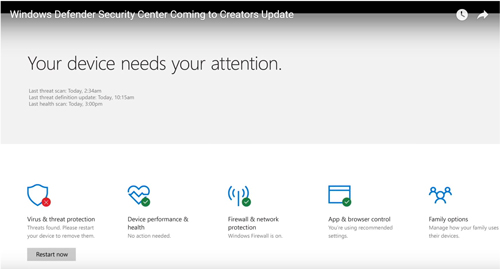News
New Security Center Coming to Windows 10 'Creators Update'
- By Kurt Mackie
- January 24, 2017
The forthcoming Windows 10 "Creators Update" will include a new Security Center feature, Microsoft said this week.
The Creators Update is expected to arrive sometime this spring, possibly in April. The "Windows Defender Security Center" will provide a centralized view, perhaps aimed more toward consumer users, showing that various computer security protections are turned on. Green check-marks will signify that protective services are working, while red "x" symbols will point to problems (see screenshot):
 [Click on image for larger view.] Screenshot of the Security Center coming to the Windows 10 Creators Update. (Source: Microsoft video.)
[Click on image for larger view.] Screenshot of the Security Center coming to the Windows 10 Creators Update. (Source: Microsoft video.)
The Security Center feature can be tested now by Windows Insider Program participants. It's accessed in the current Windows 10 test release "under All Apps in the Start Menu," Microsoft's announcement indicated. This test build also has new "quick" and "full" scan user interface options for Windows Defender, as well as device "health scans" features, Microsoft has previously indicated.
Windows Defender itself is the free anti-malware software that comes preinstalled with Windows 10. The Security Center part is somewhat like a bundled-up segment of Windows 10's Control Panel, but Microsoft is nonetheless giving it the Windows Defender stamp.
The new Security Center will have the following controls:
- Virus and Threat Protection
- Device Performance and Health
- Firewall and Network Protection
- App and Browser Control and
- Family Options
The Virus and Threat protection control will show security-scan results, as well as history, for Windows Defender users. However, if another vendor's anti-malware software has been installed, then this control can be used to launch that solution, Microsoft's announcement explained.
The Device Performance and Health control will show the "latest Windows updates, drivers, battery life and storage capacity." Users can also perform a clean install of Windows 10 from this screen, if wanted, via a "Refresh" command.
The Firewall and Network Protection control will have "links to network troubleshooting information," Microsoft's announcement promised. The App and Browser control will let users adjust SmartScreen settings. SmartScreen is a reputation-check service for Web sites, apps and downloads. The Family Options control adds parental permission controls.
The Windows Defender anti-malware software itself hasn't typically topped the list of the best anti-virus software in competition with products from other consumer security software vendors. However, Windows Defender did make the bottom third ranking in AV-Test's October 2016 ranking, which is an indication of progress. Users can install anti-malware software from other vendors on Windows 10 systems, but Windows Defender will kick in if that software is seen as somehow incompatible with Windows 10.
This automatic switch to Windows Defender, without notifying users, is one of the legal complaints recently lodged by Kaspersky Lab against Microsoft. The software security firm has also complained that anti-malware software vendors now just have "several days" to keep current with Microsoft's frequent Windows 10 update releases, instead of a past practice of having two months to prepare.
Microsoft's announcement seemed to include a response, of sorts, at least with regard to Windows Defender's propensity to kick in.
"This new experience [regarding the Security Center] naturally supports customer choice in selecting an AV product," Microsoft's announcement stated. "In addition, if your subscription or paid antivirus software should expire, Windows Defender Antivirus will kick in to provide protection by default until you take further action. Finally, it is important to ensure that you are in control of your PC. Windows 10 respects your freedom to choose protection software and services that you like best."
Still, it's apparent that anti-malware software vendors outside Microsoft have struggled at times to keep their products in tune with frequent Windows 10 changes. Consumers could just stick with Windows Defender should Windows 10 detects a compatibility problem with their releases.
While Windows Defender comes free with Windows 10, Microsoft gains anti-malware "telemetry" information from consumer users that can be used to support its commercial security products for businesses.
About the Author
Kurt Mackie is senior news producer for 1105 Media's Converge360 group.